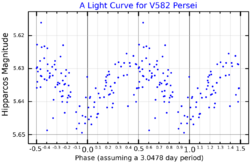Astronomy:50 Persei
| Observation data Equinox J2000.0]] (ICRS) | |
|---|---|
| Constellation | Perseus |
| Right ascension | 04h 08m 36.61660s[2] |
| Declination | +38° 02′ 23.0488″[2] |
| Apparent magnitude (V) | 5.52[3] |
| Characteristics | |
| Spectral type | F7 V[4] |
| U−B color index | +0.00[3] |
| B−V color index | +0.54[3] |
| Variable type | RS CVn and BY Dra |
| Astrometry | |
| Radial velocity (Rv) | +26.2[5] km/s |
| Proper motion (μ) | RA: +164.10[2] mas/yr Dec.: −202.60[2] mas/yr |
| Parallax (π) | 47.63 ± 0.26[2] mas |
| Distance | 68.5 ± 0.4 ly (21.0 ± 0.1 pc) |
| Absolute magnitude (MV) | 3.87[6] |
| Details | |
| Mass | 1.16[7] M☉ |
| Surface gravity (log g) | 4.35[7] cgs |
| Temperature | 6,147[7] K |
| Metallicity [Fe/H] | −0.11[7] dex |
| Rotational velocity (v sin i) | 20.81[8] km/s |
| Age | 0.60[9] Gyr |
| Other designations | |
| Database references | |
| SIMBAD | data |
50 Persei is a star in the constellation Perseus. Its apparent magnitude is 5.52,[3] which is bright enough to be seen with the naked eye. Located around 21.00 parsecs (68.5 ly) distant, it is a White main-sequence star of spectral type F7V,[4] a star that is currently fusing its core hydrogen. In 1998 the star was named a candidate Gamma Doradus variable with a period of 3.05 days,[6] which would means it displays variations in luminosity due to non-radial pulsations in the photosphere. Subsequently, it was classified as a RS Canum Venaticorum and BY Draconis variable by an automated program.[11]
This is probably a binary system with an unseen companion. It is physically associated with the likely binary system HIP 19255, with the two pairs orbiting each other over a time scale of around a million years. The components of HIP 19255 have an angular separation of 3.87″ and the two components orbit each other every 590 years. 50 Persei may share a gravitational association with Capella, even though the two are separated by nearly 15° − equivalent to a distance of 19 ly (5.9 pc).[12]
50 Persei is emitting an infrared excess at a wavelength of 70 μm, suggesting the presence of a circumstellar debris disk. The disk has a temperature of 96±5 K.[9]
References
- ↑ "Light Curve". ESA. https://www.cosmos.esa.int/web/hipparcos/java-tools/light-curve.
- ↑ 2.0 2.1 2.2 2.3 2.4 van Leeuwen, F. (2007), "Validation of the new Hipparcos reduction", Astronomy and Astrophysics 474 (2): 653–664, doi:10.1051/0004-6361:20078357, Bibcode: 2007A&A...474..653V.
- ↑ 3.0 3.1 3.2 3.3 Mermilliod, J.-C. (1986), "Compilation of Eggen's UBV data, transformed to UBV (unpublished)", SIMBAD Astronomical Database, Bibcode: 1986EgUBV........0M.
- ↑ 4.0 4.1 Maldonado, J. et al. (October 2010), "A spectroscopy study of nearby late-type stars, possible members of stellar kinematic groups", Astronomy and Astrophysics 521: A12, doi:10.1051/0004-6361/201014948, Bibcode: 2010A&A...521A..12M.
- ↑ Nordström, B. et al. (2004), "The Geneva-Copenhagen survey of the Solar neighbourhood. Ages, metallicities, and kinematic properties of ~14000 F and G dwarfs", Publications of the Astronomical Society of Australia 21 (2): 129–133, doi:10.1071/AS04013, Bibcode: 2004PASA...21..129N.
- ↑ 6.0 6.1 Aerts, C.; Eyer, L.; Kestens, E. (September 1998), "The discovery of new gamma Doradus stars from the HIPPARCOS mission", Astronomy and Astrophysics 337: 790–796, Bibcode: 1998A&A...337..790A.
- ↑ 7.0 7.1 7.2 7.3 Chen, Y. Q. et al. (February 2000), "Chemical composition of 90 F and G disk dwarfs", Astronomy and Astrophysics Supplement 141 (3): 491–506, doi:10.1051/aas:2000124, Bibcode: 2000A&AS..141..491C.
- ↑ Martínez-Arnáiz, R. et al. (September 2010), "Chromospheric activity and rotation of FGK stars in the solar vicinity. An estimation of the radial velocity jitter", Astronomy and Astrophysics 520: A79, doi:10.1051/0004-6361/200913725, Bibcode: 2010A&A...520A..79M, http://eprints.ucm.es/37826/1/davidmontes17libre.pdf, retrieved 2018-11-04.
- ↑ 9.0 9.1 Beichman, C. A. et al. (December 2006), "New Debris Disks around Nearby Main-Sequence Stars: Impact on the Direct Detection of Planets", The Astrophysical Journal 652 (2): 1674–1693, doi:10.1086/508449, Bibcode: 2006ApJ...652.1674B.
- ↑ "* 50 Per". SIMBAD. Centre de données astronomiques de Strasbourg. http://simbad.u-strasbg.fr/simbad/sim-basic?Ident=%2A+50+Per.
- ↑ Dubath, P.; Rimoldini, L.; Süveges, M.; Blomme, J.; López, M.; Sarro, L. M. et al. (2011), "Random forest automated supervised classification of Hipparcos periodic variable stars", Monthly Notices of the Royal Astronomical Society 414 (3): 2602–17, doi:10.1111/j.1365-2966.2011.18575.x, Bibcode: 2011MNRAS.414.2602D.
- ↑ Shaya, Ed J.; Olling, Rob P. (January 2011), "Very Wide Binaries and Other Comoving Stellar Companions: A Bayesian Analysis of the Hipparcos Catalogue", The Astrophysical Journal Supplement 192 (1): 17, doi:10.1088/0067-0049/192/1/2, 2, Bibcode: 2011ApJS..192....2S.
 |

